Explore Khovsgol Province - Mongolia Travel, Asia
Known as the "Blue Pearl of Mongolia," Khovsgol Province is a veritable gold mine of scenic beauty and cultural diversity. Nestled in the northern part of the country, this region is home to the stunning Khovsgol Lake, verdant landscapes, and a unique blend of nomadic traditions. Whether you're an adventure seeker, a history buff, or someone looking to experience authentic Mongolian culture, Khovsgol has something for everyone.
Population: Approximately 132,000 in 2017.
Economy: One of the top tourist destinations in Mongolia, Khovsgol’s serene and beautiful landscape have become the main source of economic growth of the region.
Landmarks: Famous for Khovsgol Lake, Tsaatan Reindeer Herders, and Horzog National Park.
Mongolia
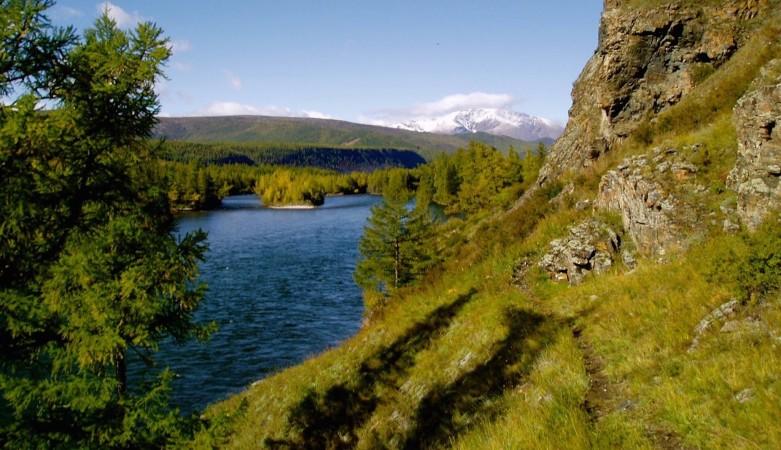
Overview of Khovsgol Province
History & Cultural Influence
The history of Khovsgol Province is as extensive and profound as the waters of its renowned lake. Historically, this region has been a melting pot of various Mongolian tribes and ethnic groups, including the Darkhad and Tsaatan people. The area's strategic location made it an essential crossroad for traders and travelers, contributing to its diverse culture. The cultural heritage of Khovsgol is deeply intertwined with its natural surroundings. The sophisticated craft of felt-making and the distinctive techniques of herding reindeer are among the many customs that the local people have managed to hold onto.
Interaction with The Locals
Khovsgol Province, located in northern Mongolia, has a population of approximately 132,000 people. Numerous ethnic groups, including the Darkhad, Tsaatan, and Khalkha Mongols, call the region home. The locals are known for their traditional nomadic lifestyle, which revolves around herding livestock such as yaks, sheep, and reindeer. The people of Khovsgol are renowned for their warm hospitality and rich cultural heritage, which includes shamanistic practices and unique crafts. This blend of cultural diversity and traditional customs makes Khovsgol a fascinating destination for visitors.

Khovsgol Lake in winter - © Britannica
Top Attractions in Khovsgol Province
These attractions offer a diverse range of experiences, from natural wonders and outdoor adventures to cultural insights, making Khovsgol Province a compelling destination for travelers seeking both beauty and adventure.
- Khovsgol Lake (Khövsgöl Nuur): The crown jewel of the province, often dubbed the "Blue Pearl of Mongolia." Not only is this enormous freshwater lake the biggest in Mongolia, but it's also among the cleanest, clearest in the world. Surrounded by dense forests and rugged mountains, the lake offers breathtaking views and a serene environment.
- Tsaatan Reindeer Herders: The Tsaatan are one of the few remaining nomadic reindeer herding communities in the world. Visiting their camps offers a rare opportunity to learn about their lifestyle, traditions, and deep connection to nature. The herders are known for their warm hospitality and willingness to share their way of life with curious travelers.
- Mongolian Taiga: The Mongolian Taiga, a vast and rugged wilderness area, offers breathtaking landscapes of dense forests, rolling hills, and snow-capped peaks. It's a haven for wildlife enthusiasts and those interested in trekking through untouched natural beauty.
- Horzog National Park: This national park is known for its diverse ecosystems, including mountains, valleys, and rivers. Visitors can explore its rich biodiversity, including various species of flora and fauna, and enjoy outdoor activities like hiking and bird-watching.
- Ulaan Uul Mountain: A prominent peak in the Khovsgol region, Ulaan Uul Mountain provides stunning panoramic views of the surrounding landscapes. It's a popular spot for hiking and offers a serene environment for nature lovers.
- Jankhangad Sand Dunes: These sand dunes offer a unique desert-like landscape within the northern part of Mongolia. Visitors can enjoy activities such as sandboarding and camel riding, and experience the contrast of the dunes against the lush surrounding terrain.
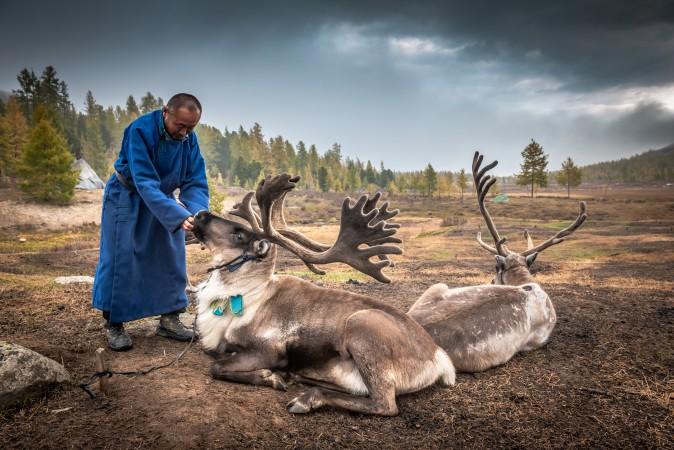
Tsaatan Reindeer Herders - © indy
Must-Try Dishes in Khovsgol Province
Khovsgol Province's cuisine is a reflection of its nomadic lifestyle. These dishes offer a taste of the authentic flavors and culinary traditions of Khovsgol Province, making them must-try local delights for any visitor.
- Khorkhog: A unique Mongolian dish where mutton is steamed with vegetables in a sealed container, often a metal or clay pot. The tastes of the herbs and veggies soak into the meat, rendering it soft.
- Buuz: Steamed dumplings filled with minced meat (usually beef or lamb) and seasoned with garlic and onions. Buuz is a staple in Mongolian cuisine and often enjoyed during festive occasions.
- Suutei Tsai (Traditional Mongolian Milk Tea): A staple beverage in Mongolia, made from black tea, milk, and sometimes salt. This warm and comforting drink is a perfect accompaniment to any meal.
- Khuushuur: A traditional stew prepared with meat, root vegetables, and various herbs. It is slow-cooked to enhance the flavors and provide a hearty dish that reflects the nomadic lifestyle.
- Boortsog: Deep-fried dough pastries that are slightly sweet and often enjoyed with tea or as a snack. They have a light and fluffy texture that complements their rich flavor.
- Tsuivan (Traditional Mongolian Cheese): A variety of cheeses made from cow or goat milk, including soft, creamy, and aged varieties. Mongol cheese is commonly used as a snack or used in cooking.

Suutei Tsai (Mongolian Milk Tea) - © Slurrp
Festivals & Local Celebrations
Khovsgol Province is home to vibrant festivals like the Naadam and Ice Festival, offering unique cultural experiences while smaller local events throughout the year also provide insight into the region's traditions.
Naadam Festival
The Naadam Festival is Mongolia's most significant cultural event, celebrated nationwide, including in Khovsgol. The "Three Manly Games"—wrestling, horse racing, and archery—are highlighted at this event, which honors ancient Mongolian sports. In Khovsgol, the festival is often accompanied by folk music, dance performances, and vibrant parades, offering a festive atmosphere for both locals and tourists.
Ice Festival
Held annually on the frozen surface of Khovsgol Lake, the Ice Festival is a unique winter event that celebrates the region's cold season. Activities include ice skating, ice-fishing competitions, and horse-drawn sled races. The festival also features traditional performances and cultural displays, providing a colorful insight into local customs.
Local Cultural Events
Throughout the year, Khovsgol hosts various smaller festivals and cultural events that showcase its rich traditions. These include shamanic rituals, traditional craft fairs, and local music and dance performances. These events provide visitors with an opportunity to engage with the local community and experience the province's cultural diversity.

Naadam Festival - © CNN
What to Do in Khovsgol Province
Khovsgol Province offers diverse activities for tourists, including outdoor adventures like horseback riding and hiking, cultural tours, and wildlife exploration. Make sure that you include them in your Mongolia adventure itinerary.
Outdoor Adventures
Khovsgol Province is a paradise for outdoor enthusiasts. The region offers a range of activities, from horseback riding across the vast steppes to hiking through the dense forests surrounding Khovsgol Lake. For those seeking adventure, mountain biking and kayaking on the lake provide thrilling ways to explore the landscape.
Cultural Tours
Cultural tours are a great way to delve into the local heritage. Visitors can explore historical sites, such as ancient deer stones and petroglyphs, or visit local museums that showcase artifacts and exhibits on Khovsgol's history and culture. Participating in traditional ger stay experiences allows travelers to live like nomads, learning about daily life, traditional crafts, and the importance of livestock in the local economy.
Wildlife and Nature Exploration
Khovsgol's rich biodiversity makes it a hotspot for wildlife enthusiasts. The region is home to a variety of animals, including ibex, elk, and numerous bird species. Bird watching and wildlife photography are popular activities, especially in the Darkhad Valley and around Khovsgol Lake. The area also offers opportunities for eco-tours, focusing on conservation efforts and sustainable tourism practices.
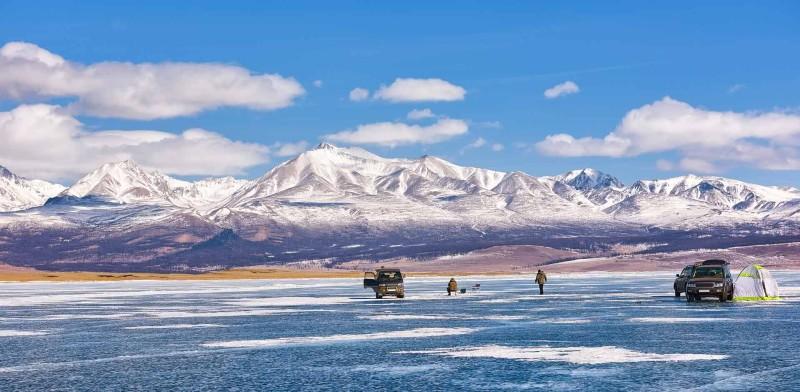
Camping at Khovsgol Lake during winter - © Mongolia Tourism
Shopping in Khovsgol Province
Khovsgol offers a rich shopping experience with a variety of local crafts, including felt products and wooden carvings. Shopping in Khovsgol Province not only provides visitors with unique souvenirs but also supports the local economy and preserves traditional crafts.
Local Markets in Murun
Murun, the provincial capital, is home to bustling markets where you can find a variety of local crafts and souvenirs. Popular items include handmade felt products, traditional Mongolian clothing, and wooden carvings. These markets provide visitors a look into the artisan culture of the area and a chance to buy genuine, regionally produced items.
Shops in Khatgal
The town of Khatgal, located near Khovsgol Lake, is another great spot for shopping. Here, you can explore shops that specialize in Tsaatan-made crafts, including unique reindeer leather items and traditional jewelry. Khatgal is a perfect place to pick up a unique keepsake or gift.
Artisan Workshops
Throughout the province, artisan workshops offer handcrafted goods, such as intricate felt rugs, bags, and accessories. Visiting these workshops allows you to see the artisans at work and learn about the traditional techniques used in their craft. It's also a great opportunity to directly support regional craftspeople.
Cultural Centers and Souvenir Shops
Cultural centers and souvenir shops scattered across Khovsgol Province provide a curated selection of local art, crafts, and other unique items. These venues often feature high-quality products that reflect the region's cultural heritage and artistic traditions.

Travel to Khatgal town to seek unique souvenirs - © BlackBoxGuild
Weather in Khovsgol Province: Best Time to Visit
Spring in Khovsgol Province
Spring in Khovsgol Province sees temperatures gradually rising from the winter chill, with averages ranging from -5°C to 10°C (23°F to 50°F). As the snow melts, the landscape awakens with blooming wildflowers and budding trees. This season marks the beginning of the tourist influx, particularly for nature lovers and those interested in bird watching and springtime photography.
Summer in Khovsgol Province
Summer is the peak tourist season in Khovsgol Province, with temperatures ranging from 10°C to 25°C (50°F to 77°F). The warm and pleasant weather makes it ideal for outdoor activities such as trekking, boating, and exploring the stunning Khovsgol Lake. Festivals and cultural events also draw visitors, offering a vibrant glimpse into local traditions and celebrations.
Autumn in Khovsgol Province
Autumn brings cooler temperatures, ranging from 0°C to 15°C (32°F to 59°F), and a spectacular display of fall foliage. This is a great time for those who prefer a quieter experience, as the crowds thin out after the summer peak. The crisp air and clear skies provide perfect conditions for hiking and photography, capturing the golden hues of the landscape.
Winter in Khovsgol Province
Winter in Khovsgol Province is characterized by harsh cold, with temperatures often dropping below -30°C (-22°F). Despite the extreme cold, winter offers unique attractions such as the Ice Festival, ice fishing, and opportunities for snow sports around Khovsgol Lake. This season attracts adventure seekers and those interested in experiencing the region's winter wonderland.
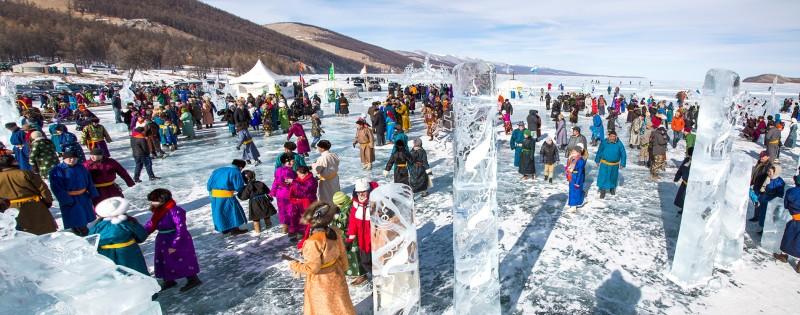
Winter is the best time to participate in Ice Festival - © Mongolia Discover
Cultural Etiquette in Khovsgol Province
Respecting Local Traditions
Khovsgol Province is rich in cultural heritage, and visitors are encouraged to respect and observe local customs.
- Khadag ceremony: This is where a ceremonial scarf is presented as a sign of respect or blessing. If you receive a khadag, accept it with both hands and a slight bow.
- Ger customs: Enter a nomadic family's ger (yurt) with your right foot first and to stay off the threshold, which is revered as a holy line. Inside the ger, be mindful of the seating arrangement, with the place of honor typically located directly opposite the door.
Interaction with Locals
Mongolians are known for their warm hospitality. When greeting someone, a slight bow or nod accompanied by a friendly smile is common. As a token of friendliness, it's also usual to softly touch the other person's arm or shoulder during a handshake. If you wish to take photographs, especially of people, always ask for permission first. In rural areas and during cultural events. Building relationships with locals can also be facilitated by learning a few simple phrases in Mongolian, including "Sain baina uu?" (Hello) and "Bayarlalaa" (Thank you).
Dress Code
While there is no strict dress code, it’s respectful to dress modestly, especially when visiting religious sites or participating in traditional ceremonies. In many rural areas, wearing traditional Mongolian attire like the "deel" is appreciated and can be a unique way to immerse yourself in the local culture.
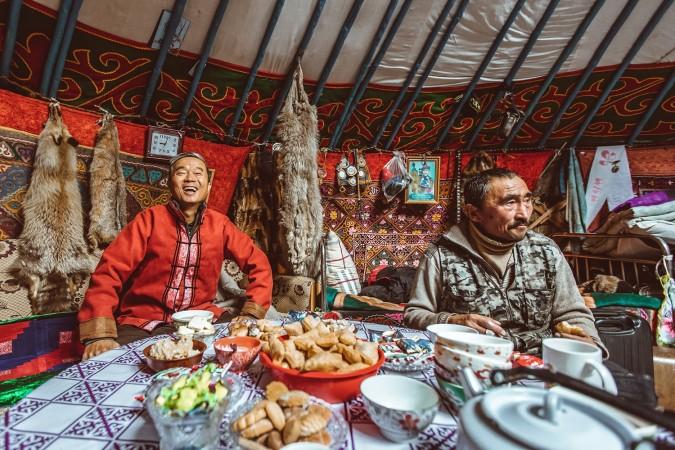
Dinner with the local in their ger - © Mongolia Tourism
Essential Travel Information
Getting Around Khovsgol Province
Khovsgol Province is accessible by air and land, with various local transportation options including buses, taxis, and rental cars. Eco-friendly travel options are also encouraged.
- Navigating Khovsgol Province: Khovsgol Province is accessible by air, with flights available to Murun Airport from Ulaanbaatar, Mongolia's capital. The flight takes about 1.5 hours. Alternatively, travelers can opt for a scenic overland journey by bus or car, which takes approximately 12-14 hours.
- Local Transportation: Within the province, transportation options include buses, taxis, and rental cars. For those looking to explore the more remote areas, hiring a local guide with a 4x4 vehicle is advisable. Horseback riding is also a popular and traditional way to travel, especially in rural regions.
- Eco-Friendly Travel Options: Khovsgol Province promotes eco-friendly tourism. Visitors are encouraged to use bicycles or participate in eco-tours that minimize environmental impact. Some accommodations also offer shuttle services to nearby attractions, reducing the need for individual vehicle use.
ATM & Banking Services
ATM services in Khovsgol Province are mainly found in larger towns such as Murun and Khatgal, where international travelers should ensure their bank cards are compatible with local ATMs, which generally accept Visa and MasterCard. It is wise to withdraw cash ahead of time when venturing into more remote areas, as ATM availability can be scarce. Currency exchange services are offered in major towns, with facilities available at some hotels.
Where to Stay in Khovsgol Province
Khovsgol Province provides a variety of accommodation options to suit different budgets. In towns like Murun and Khatgal, visitors can choose from comfortable hotels and guesthouses with modern amenities, ideal for exploring the region. For a more authentic experience, traditional Mongolian ger (yurt) camps are available, particularly near Khovsgol Lake, offering a unique glimpse into nomadic life. These camps range from basic to luxury, with some featuring amenities like hot showers and traditional meals.
Articles for you

Explore Yala National Park - Sri Lanka Travel, Asia
Tucked away in Sri Lanka’s southeastern corner, Yala National Park is where wild nature meets deep tradition. Known worldwide for its leopard population, the park is also home to elephants, sloth bears, crocodiles, and hundreds of bird species. Beyond wildlife, Yala opens doors to a cultural landscape dotted with ancient temples, Buddhist ruins, and coastal villages. For travelers seeking more than just a safari, Yala offers a chance to explore eco-tourism, local communities, and sacred heritage sites.
Population: The Yala National Park area doesn’t have a human population.
Economy: The economy around Yala National Park thrives on a blend of eco-tourism, agriculture, and local services. Safari tours, eco-lodges, and cultural experiences drive steady income for nearby towns like Tissamaharama and Kataragama, supporting thousands of families.
Landmarks: Famous for Block I of Yala and wildlife encounters, including elephants, sloth bears, crocodiles, and exotic bird species.

Explore Galle - Sri Lanka Travel, Asia
Nestled on Sri Lanka’s southern coastline, Galle is a vibrant city where history meets the sea. Its cobbled streets, colonial architecture, and serene beaches make it a must-visit destination for travelers seeking a blend of culture, adventure, and relaxation. A UNESCO World Heritage site, Galle captivates visitors with its Dutch Fort, bustling markets, and friendly locals. Whether you’re exploring the ramparts at sunset or savoring fresh seafood by the shore, Galle promises an unforgettable journey into Sri Lanka’s heritage.
Population: Approximately 113,000 in 2023.
Economy: Galle’s economy thrives on tourism, trade, and fisheries. The city’s historic fort, colonial architecture, and coastal charm draw thousands of international visitors each year, making tourism its main economic driver. Fishing remains vital for local livelihoods, supplying fresh seafood across the region.
Landmarks: Famous for the Galle Fort, Dutch Reformed Church & Maritime Museum, and Unawatuna Beach.

Explore Bentota - Sri Lanka Travel, Asia
Nestled along Sri Lanka’s southwestern coast, Bentota is a tropical paradise that blends golden beaches, vibrant culture, and thrilling adventures. Famous for its calm waters, luxury resorts, and scenic river estuary, Bentota has become a top destination for travelers seeking both relaxation and authentic experiences. From serene beach walks at sunrise to adrenaline-pumping water sports, this coastal town offers a perfect balance of leisure and exploration. With its proximity to Colombo and Galle, Bentota is easy to reach, making it an ideal stop for both short escapes and extended holidays.
Population: Approximately 37,000 in 2023.
Economy: Bentota’s economy thrives mainly on tourism, which drives local businesses such as hotels, restaurants, and wellness retreats. The town also benefits from fishing, coconut cultivation, and handicrafts like wood carving and batik textiles. Many residents rely on the growing demand for water sports and Ayurvedic treatments, making tourism the backbone of both income and employment in the area.
Landmarks: Famous for Bentota Beach, Bentota River Safari, and Kande Vihara Temple.

Explore Mirissa - Sri Lanka Travel, Asia
Mirissa is a charming coastal town on Sri Lanka’s southern shoreline. Known for its golden beaches, turquoise waters, and vibrant marine life, it has become a must-visit stop for travelers exploring the island. Many come for whale watching, surfing, and sunset views at Coconut Tree Hill, but Mirissa offers much more than postcard beauty. The fishing boats you see anchored by the bay carry generations of stories. Local traditions, delicious cuisine, and a laid-back rhythm of life shape every visitor’s experience.
Population: Approximately 4,700 in 2023.
Economy: Mirissa’s economy is largely shaped by its coastal location. Fishing has long been the backbone of local livelihoods, with generations relying on the Indian Ocean for income. In recent decades, tourism has become the main driver of growth, thanks to whale watching, surfing, and beachside hospitality.
Landmarks: Famous for Mirissa Beach, Coconut Tree Hill, and Parrot Rock Bridge.

Explore Nuwara Eliya - Sri Lanka Travel, Asia
Tucked away in the Central Highlands of Sri Lanka, Nuwara Eliya is often called “Little England”. With its rolling tea plantations, cool misty mornings, and colonial charm, this mountain town feels like a step into another world. Travelers come here to breathe fresh air, walk through flower gardens, sip the finest Ceylon Tea, and enjoy a pace of life far from the island’s busy cities. Whether you’re drawn by scenic landscapes, heritage architecture, or the warmth of its people, Nuwara Eliya is a destination that blends nature, culture, and history in perfect harmony.
Population: Approximately 781,000 in 2023.
Economy: Nuwara Eliya’s economy thrives mainly on tea production, as it sits in the heart of Sri Lanka’s central highlands, famous worldwide for Ceylon Tea. The city also benefits from a growing tourism industry, attracting visitors with its colonial charm, cool climate, and scenic landscapes.
Landmarks: Famous for Gregory Lake, Hakgala Botanical Garden, and Victoria Park.

Explore Sukau - Malaysia Travel, Asia
Nestled on the banks of the Kinabatangan River in Sabah, Malaysian Borneo, Sukau is a destination where wildlife, culture, and conservation come together. Known as one of Asia’s top spots for river safaris and eco-tourism, this quiet village offers a front-row seat to encounters with Bornean orangutans, pygmy elephants, proboscis monkeys, and exotic birdlife.
Population: Approximately 1,400 in 2019.
Economy: Sukau’s economy is shaped by its riverine location and natural resources. Traditionally, the Orang Sungai community relied on fishing, small-scale farming, and forest gathering for their livelihood. Today, the village has shifted toward eco-tourism, with river cruises, jungle trekking, and homestays providing income.
Landmarks: Famous for the Kinabatangan River cruises, Gomantong Caves, and Ox-bow lakes and wetlands.
